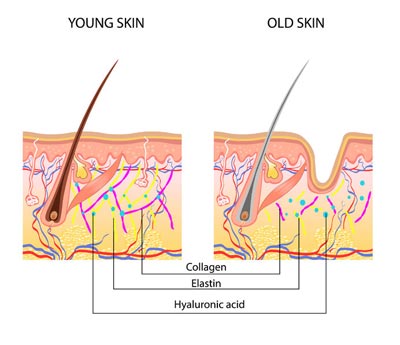Top Tips For Boosting Collagen Production

We can’t stress enough the importance of collagen and the role it plays in your body. Collagen is the most abundant protein in the human body. Almost every aspect of your health, bone formulation, skin, hair, teeth, organs, arteries, muscles, intestinal tract, connective tissue and the ability to heal is tied to collagen.
Collagen is used in many medical treatments related to complications of the bones and skin. It is used in cardiac applications, cosmetic surgery, bone grafts, tissue regeneration, reconstructive surgery and wound care for humans and animals.
Collagen Production and Age

Top Tips for Increasing Your Collagen
1. Feed Your Skin
Using probiotic skin care formulations like those created by Nayelle you feed your skin the nutrition it needs to naturally stimulate new collagen production.
During the process of bio fermentation (probiotics), Nayelle’s special ingredients including Snow Mushroom, Sea Kelp and Goat Milk Kefir are further broken down and concentrated. These concentrated ingredients now contain even more nutrients and minerals and can be more easily absorbed into the skin to help provide antioxidants, vitamins, minerals, peptides, essential 3-6-9 omega fatty acids and amino acids. All of these compounds have an incredibly beneficial effects for all skin types and aid in the natural creation of collagen.
The skin’s cells need proteins to build collagen and elasticity and require the right ingredients to do so. The skin can not fully achieve this nutrition level from topical or internal ingestion of collagen supplements. Collagen and the elasticity that comes with it needs to be created internally by your skin’s cells. Feed your skin for firmer, more radiant and youthful looking skin.
2. A Well-Rounded Diet
A well rounded diet consisting of fresh fruits, vegetables and healthy fats and proteins is essential to collagen production.
Collagen is a protein made mainly of four amino acids: Glycine, proline, hydroxyproline, and arginine. By eating healthy sources of proteins such as meats, eggs, seafood, and plant-based sources such as beans and soy, you can ensure you have all the amino acids necessary for collagen production.
Healthy omega-3 fats are also vital for collagen production. This is because skin cells are surrounded by a fatty layer of skin, called the hypodermis (the innermost layer of the skin). When you consume healthy, omega-3 fats found in seafood, grass fed beef, flaxseed, and other sources, you can ensure your skin cells remain plump and disguise the wrinkles that appear with age.
One great option for those looking to increase collagen production through their diet is to make a Collagen Broth. Collagen broth, or bone broth, is an excellent source of amino acids, collagen and other trace minerals that support the collagen cycle in the body.
3. Collagen Supplements
Dietary collagen supplements do exist and work. One must be very careful selecting collagen supplements because they are not created equally. The process for creating collagen supplements requires collagen to be hydrolyzed. The hydrolyzed collagen is reduced to small peptides which can be ingested in the form of dietary supplement with the intent to help your joints, digestive tract, bone health and skin. The source of collagen is derived from 4 main sources: Bovine, Chicken, Fish and Eggs:
-
Bovine or Beef Collagen
When we talk about Bovine collagen we are talking about hydrolyzed collagen. Hydrolyzed collagen is derived from breaking down the bones, hides and cartilage of cows and then converting it into a dietary supplement or powder. The absorption rate of hydrolyzed collagen is very high (up to 90%) when compared to the absorption rate of collagen derived from eating regular food (27% or less). Bovine cartilage provides Type 1 and Type 3 collagen. These types of collagen are required for healthy hair, skin, bones, teeth, connective tissue, ligaments, tendons, muscles and even gut health.
-
Chicken Collagen
Type 2 collagen is most abundant in chicken collagen. Type 2 collagen is best for building cartilage. Chicken collagen is very beneficial for joint health, especially since this source also provides chondroitin sulfate and glucosamine sulfate, both of which have anti-aging effects. Chicken collagen is usually seen as the cheapest and most abundant source of collagen in dietary supplements. This does not necessarily mean it is worse than any other form of dietary collagen supplement.
-
Fish Collagen
Collagen derived from fish is primarily Type 1 collagen. Type 1 collagen comes with the important amino acids glycine, proline and hydroxyproline. Consuming fish collagen has benefits for the joints, skin, vital organs, blood vessels, digestion and bones. Hydroxyproline is an important component has been proven to help combat joint degradation and signs of aging.
-
Egg Collagen
Egg collagen is derived from egg shells and egg whites. It contains mostly Type 1 collagen. Egg collagen also contains more Type 3, 4 and 10, collagen then the other sources of collagen already noted. It provides glucosamine sulfate, chondroitin sulfate, hyaluronic acid and various amino acids that have benefits for building connective tissue, wound healing, building muscle mass and reducing pain/stiffness. It is also great for healthy skin, teeth and hair.
4. Vitamin C
Vitamin C is required as a cofactor many of the processes of collagen production and synthesis to occur. By consuming foods high in vitamin C, such as citrus fruits, guava, and vegetables such as yellow bell peppers and dark leafy greens, you can ensure you’re never deficient in this essential nutrient.
5. Regular Exercise / Resistance Training
Exercise stimulates the production of Human Growth Hormone (HGH). HGH stimulates collagen production in muscles and tendons. If you want to focus on maximizing your HGH / collagen production you will want to focus on resistance and endurance training. Lifting heavier loads with high frequency rapidly increases the amount of HGH created by the body. You should focus on large muscle groups for the best results. The more muscle fibers you put into play the more efficiently your body will produce HGH.
For the most efficient endurance training you should cut training time to 10 to 15 minutes and perform these short bursts of exercise multiple times a day if possible. When you exercise for long periods of time, cortisol levels will rise and HGH levels will fall. Short interval endurance training increases HGH levels almost immediately and continues to do so for up to 24 hours following a workout.
6. Healthy Sleep (7-9 Hours)
Sleep is your bodies regeneration time. Studies have proven that 7 to 9 hours of sleep every night is needed for proper restorative processes including the production of collagen. Poor sleep has long been connected with increased stress hormones that can exacerbate skin problems and breakdown your bodies natural collagen and hyaluronic acid production processes.
7. Light Therapies
Looking to take your collagen production to the next level? Two light therapy treatments can help. Red LED light therapy and infrared light therapy are both known to stimulate collagen production at deeper skin levels.
Red light therapy is UV-free and produces a wavelength outside of those that damage skin. This creates healing benefits for the skin, which can increase collagen production. LED red light therapy stimulates fibroblasts to produce collagen while decreasing the enzymes that break them down.
Infrared light therapy stimulates Type I and III collagen production. These types of collagen improve skin elasticity and tone while diminishing the appearance of wrinkles. Infrared light therapy increases the levels of collagen and elastin produced by fibroblasts.
Studies have shown that these types of light therapy treatments show results when the treatments are consistently applied during the course of several months.
Conclusion – Boosting Your Collagen Production
We hope this article has helped you to get a better understanding and appreciation of the role collagen plays in your body. It has a direct influence on so many of our physical attributes including the health of our skin, hair, teeth, connective tissues, ligaments, tendons, arteries, bones, digestive tract and the ability of the body to heal. As we age collagen production diminishes. It is important to make every effort to keep our bodies producing as much collagen as possible.
We can start by feeding our skin with proper nutrition with probiotic moisturizers to stimulate the development of new collagen and protect what we already have. Good sleep, exercise, a healthy diet also play important roles in collagen production. There are many forms of dietary collagen that can help aid our bodies too. Even Red light therapy treatments can be used to help aid our skin with a collagen boost.


